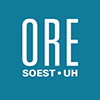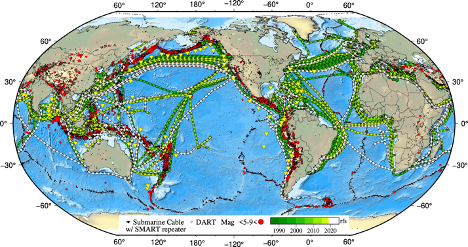To subscribe to the ORE seminar mailing list, click here.
For a (working draft) list of upcoming seminars, click here.
If you are interested in giving an ORE seminar, please contact us at nosal [at] hawaii [dot] edu.
ocean observing
Seminar: Development of a solid state, dual pH and Total Alkalinity sensor for in situ monitoring of the seawater carbon dioxide system
Burns Hall 4005 1601 East-West Road, Honolulu, HI, United StatesDr. Ellen Briggs Post-Doctoral Researcher Scripps Institute of Oceanography A novel design is demonstrated for a solid state, reagent-less sensor capable of rapid and near simultaneous measurement of pH and Total Alkalinity (AT) using ion sensitive field effect transistor (ISFET) technology to provide a simplified means of characterization of the aqueous carbon dioxide system. ISFET-based pH sensors that achieve 0.005 precision are widely used in various oceanographic applications. A modified ISFET is demonstrated to perform a nL-scale acid-base titration of AT in under 40 s with an estimated precision of 2-10 μmol kg˗1. This method of measuring AT, a Coulometric
Seminar: Micro-rosette: a novel means of sampling for autonomous platforms
Ellen Briggs, PhD Assistant Professor Department of Ocean & Resources Engineering University of Hawai'i at Mānoa We have been developing a ‘micro-rosette’ for collecting water samples on mobile platforms such as profiling floats. Not all sensing technologies can measure at the rate required for mobile platforms so here we use this micro-rosette to collect and store samples to be measured at a later time. For Argo-style profiling floats, there is a ~9-day park cycle between profiles during which the sample analyses can be completed. The original aim was to measure DIC (dissolved inorganic carbon) through a method using a gas
Seminar: SMART Subsea Cables for Observing the Ocean and Earth: An Update
Bruce Howe Ocean and Resources Engineering School of Ocean and Earth Science and Technology University of Hawaii at Manoa JTF SMART Subsea Cables (Joint Task Force, Science Monitoring And Reliable Telecommunications, 1) is working to integrate environmental sensors for ocean bottom temperature, pressure and seismic acceleration into submarine telecommunications cables. The purpose of SMART Cables is supporting climate and ocean observation, sea level monitoring, observations of Earth structure, and tsunami and earthquake early warning and disaster risk reduction. Recent advances include regional SMART pilot systems that are the first steps to trans-ocean and global implementation. Building on the OceanObs’19 conference
Seminar: The Global Ocean Biogeochemistry Array (GO-BGC), a sensor and platform network for the global ocean
Ken Johnson, Ph.D. Senior Scientist Monterey Bay Aquarium Research Institute The ocean is under threat from a variety of processes driven by increasing atmospheric carbon dioxide such as ocean warming, changing winds and currents, decreasing pH and oxygen, and less ice cover at high latitudes. However, vast areas of the open ocean are sampled from research ships for chemical and biological properties only once per decade or less, with sampling occurring mainly in summer. Our ability to detect changes in ocean chemical and biological processes that may be occurring are greatly hindered by this undersampling. Robotic platforms carrying chemical and
Seminar: Automating and IoTing coastal water quality sensors
Zoom Meeting ID______ 972 7385 3401 Passcode: ore792Phil Bresnahan, Ph.D. Assistant Professor Department of Earth and Ocean Sciences University of North Carolina Wilmington In this talk, I will discuss developments of chemical and physical sensors, ranging from very inexpensive and simple to much more expensive and complicated. Specifically, I will describe recent projects geared toward improving the accuracy of autonomous pH sensors, developing and distributing low-cost coastal temperature and wave motion sensors, and adding simple Internet of Things modems and data management systems to both. I strive to collaborate with local stakeholders, especially watersports enthusiasts (surfers, paddleboarders, sailors) and (shell)fisheries, in order to help protect coastal environments by improving access
Seminar: Buoyancy controlled float swarms for distributed sensing in coastal waterways
Zoom Meeting ID______ 977 4017 0381 Passcode: meseminarTrevor Harrison, Ph.D. National Science Foundation Fellow Department of Mechanical Engineering University of Washington Abstract Buoyancy-controlled underwater floats have produced a wealth of in situ observational data from the open ocean. When deployed in large numbers, or ‘swarms’, floats offer a unique capacity to simultaneously map, in three-dimensions, environmental variables, such as currents, temperatures, and dissolved oxygen. This sensing paradigm is equally relevant in coastal waterways, yet remains underutilized due to economic and technical limitations of existing platforms. To that end, we have developed the microFloat, a buoyancy-controlled float designed specifically for the strong currents and density gradients observed in
Seminar: Observing the Ocean and Earth with SMART Subsea Cables
Holmes 247 2540 Dole Street, Honolulu, HI, United StatesDr. Bruce Howe Chair, Joint Task Force for SMART Subsea Cables Research Professor, University of Hawai'i at Mānoa Location Information: **this seminar will be held both in person (Holmes Hall 247) and over Zoom** Meeting ID: 960 4654 5799 Passcode: OREseminar https://hawaii.zoom.us/j/96046545799 JTF SMART Subsea Cables (Joint Task Force, Science Monitoring And Reliable Telecommunications, 1) is working to integrate environmental sensors for ocean bottom temperature, pressure and seismic acceleration into submarine telecommunications cables. The purpose of SMART Cables is supporting climate and ocean observation, sea level monitoring, observations of Earth structure, and tsunami and earthquake early warning and disaster risk
Seminar: An Update on the SMART Cables Initiative for Observing the Ocean and Earth
Holmes Hall 243 2540 Dole Street, Honolulu, HI, United StatesDr. Bruce Howe Research Professor, Ocean and Resources Engineering University of Hawaii at Mānoa Location Information **this seminar will be held both in person (Holmes Hall 243) and over Zoom** Meeting ID: 961 6222 2366 Passcode: OREseminar https://hawaii.zoom.us/j/96162222366 The Joint Task Force for Science Monitoring And Reliable Telecommunications (SMART) Subsea Cables is working to integrate environmental sensors (temperature, pressure, seismic acceleration) into submarine telecommunications cables. This will support climate and ocean observation, sea level monitoring, observations of Earth structure, tsunami and earthquake early warning and disaster risk reduction. We present an overview of the initiative and a description of ongoing
Seminar: Using Distributed Acoustic Sensing to observe surface gravity waves and nearshore processes
Watanabe 112 2505 Correa Rd, Honolulu, HI, United StatesDr. Hannah Glover, Postdoctoral Scholar Dr. Meagan Wengrove, Assistant Professor of Coastal Engineering College of Engineering, School of Civil and Construction Engineering Oregon State University| Location Information **This seminar will be held both in person (Watanabe Hall 112) and over Zoom** Meeting ID: 961 6222 2366 Passcode: OREseminar https://hawaii.zoom.us/j/96162222366 Distributed acoustic sensing (DAS) uses an interrogator to send pulses of laser light down fiber optic telecommunications cables. The coherent backscattered return of light from impurities in the manufactured glass to the interrogator can be used to sense environmental signal. Phase shifts in the backscattered light are directly related to cable
The Pacific Island Ocean Observing System (PacIOOS) wave-measuring buoy
Watanabe 112 2505 Correa Rd, Honolulu, HI, United StatesKimball Millikan, Marine Research Engineer Pacific Islands Ocean Observing System (PacIOOS) University of Hawaiʻi at Mānoa Location Information **This seminar will be held both in person (Watanabe Hall 112) and over Zoom** Meeting ID: 961 6222 2366 Passcode: OREseminar https://hawaii.zoom.us/j/96162222366 The PacIOOS wave buoy program maintains an array of 16 real-time wave-measuring buoys throughout the Pacific Islands. I will discuss the operation of the program, mooring design, fabrication, the components, including a brief history of Datwell and the design challenges of the Datawell Wave Rider stabilized platform to measure heave and direction, deployment and recovery techniques of the mooring system,
Advancements in passive acoustic monitoring: A framework for automated tracking of marine mammals
Watanabe 112 2505 Correa Rd, Honolulu, HI, United StatesDr. Pina Gruden Acoustics Researcher Cooperative Institute for Marine and Atmospheric Research and Department of Ocean Resources Engineering University of Hawaiʻi at Mānoa Location Information **This seminar will be held both in person (Watanabe Hall 112) and over Zoom** Meeting ID: 961 6222 2366 Passcode: OREseminar https://hawaii.zoom.us/j/96162222366 Passive acoustic monitoring (PAM) is an efficient tool for studying acoustically active sources such as marine mammals. Using a variety of sensors and array configurations, PAM can provide insights into species identity, movements, behaviors and abundance of populations, and is thus an invaluable tool for assessing and monitoring populations. With the advancement of
Seminar: Research Cruise KM-2312A,B: ACO Service and DWS Deployment
Bilger Hall 150 2545 McCarthy Mall, Honolulu, HI, United StatesClara Encke, Tyler Inkley, Kei Manabe, Will Robert, Merritt Shepherd, & Guilherme Silva Department of Ocean & Resources Engineering University of Hawai‘i at Mānoa Location Information **This seminar will be held both in person (Bilger Hall 150) and over Zoom** https://hawaii.zoom.us/j/95081858686 Meeting ID: 950 8185 8686 Passcode: OREseminar The ALOHA Cabled Observatory (ACO) 100 km north of Oahu at Station ALOHA (A Long-term Oligotrophic Habitat Assessment) is the deepest (4728 m) power and internet node on the planet, returning oceanographic data from the seafloor in realtime to shore. The ACO has been operational with plug-and-play capability since 6 June 2011.

